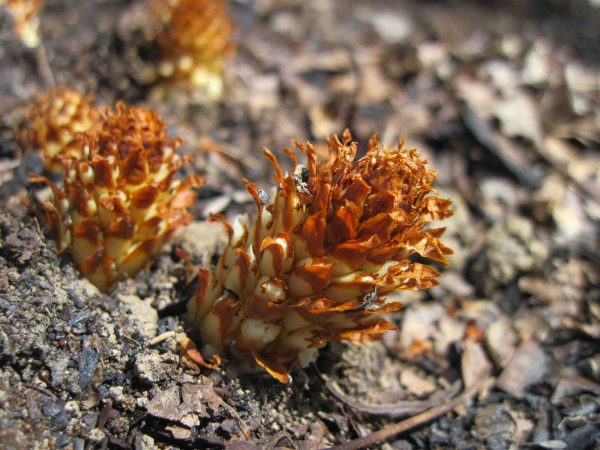Parasitic plants

The term “parasite” may bring to mind something that at best is an ugly nuisance, and at worst is a gruesome horror story – everything from common ticks and chiggers to one particularly disturbing story that popped up in my Facebook feed recently with images of a botfly being removed from someone’s eyeball. I did not feel compelled to click to see more.
However, it may be surprising to learn that in addition to these annoying and sometimes scary critters, there is also a whole family of plants that are parasites. They are called Orobanchaceae, and they uniquely do not photosynthesize. Instead they feed off other plants, depending on a host tree for nourishment. The scientific terminology for this is “achlorophyllous.” These types of plants have feeder roots (also known as haustoria) that penetrate the roots of the host plant and draw nutrients from them.
These parasites can be beautiful if you stumble upon them. A good indication you might have found one is the absence of green color, a result of their lack of photosynthesis.
I commonly see one species of this type of plant in the woods, known as beech-drops (Epifagus virginiana). If you spend much time in  the woods around here, although you might not have known what they were, more likely than not you have seen them. (Click to see photos.)
the woods around here, although you might not have known what they were, more likely than not you have seen them. (Click to see photos.)
They are typically found in groups and have a brown to pink colored stalk, with small pinkish flowers that run up the stem when they bloom, typically between August and October. As the name suggests, they feed off the roots of beech trees – so keep your eyes peeled next time you find yourself in a riparian beech forest for these interesting plants.
While hiking in the Uwharrie National Forest a few weeks ago, I spotted another parasitic plant that I’d not seen before. This one resembles a small cob of corn, which has earned it the common name of bear corn (Conopholis americana), though it is also known as cancer-root or squawroot.
American cancer-root favors hardwoods, particularly oaks and beech. The portion of the plant that is seen is usually yellow-orange to brown and typically varies in from a couple of inches to about 8 inches tall. As this plant does not photosynthesize, it doesn’t have leaves, but does have flowers in early springtime. This species is found across the eastern United States and Canada.
Only a time or two have I seen one more species in this family, known commonly as broom-rape (Orobanche uniflora). These flowers have single blooms that are usually white to light purple and occur at the top of a stalk no more than 5 inches long. They are also sometimes called ghost-pipe, perhaps a nod to their almost transparent and wisp-like appearance.
Because all these plants are not vibrant in color and grow fairly close to the ground, you may have to keep a keen eye out to spot them. If you do see them, take a minute to examine and appreciate them. Though they may send a negative impression as a parasite, they are a natural occurrence and don’t typically do much harm to their host plant. They are part of a community of species and as such have a unique purpose in the ecosystem. At the least, you’ll have to agree they’re much nicer to look at than botfly larvae.